According to Tebra, 67% of patients prefer to book appointments online. It clearly shows that healthcare is shifting toward greater convenience, as people now expect the same easy digital experience from their doctors as they do when ordering food or booking a flight.
The global telehealth market is projected to reach $455.27 billion by 2030. For forward-thinking healthcare organizations, it’s a chance to adopt a doctor appointment app development solution that weaves comfort and accessibility directly into their service model..
Are you one of those ready to move fast and adapt to gain a competitive advantage and secure a strong market share?
Then, this guide is for you. We’ll walk through everything you need to know about doctor appointment app development, backed by Uptech’s hands-on experience in healthcare software. The information in this article will help you take your first solid step to develop a doctor appointment app.
Let’s start!
What Is a Doctor Appointment App?
A doctor appointment app is a digital tool that helps patients easily schedule and manage their medical visits with healthcare providers. However, modern appointment apps often go far beyond basic scheduling. They may include electronic health records (EHRs), payment options, and built-in communication tools like chat or video calls.
With appointment apps, users can search for doctors, check available time slots, book and pay for appointments, and even access telemedicine.
For patients, it’s a convenient way to manage their healthcare on their own terms.
For clinics and hospitals, doctor booking app development helps automate admin work, reduce missed appointments, and improve the entire patient journey.
We’ll explore these benefits in more detail later in this guide.
Main Types of Doctor Appointment Apps
Before jumping into the planning stage, it’s important to understand the purpose of your solution — a crucial early step in doctor appointment booking app development.
Will it be designed for a single clinic or an entire network?
Will it serve as a marketplace where users can browse doctors from different clinics and choose the one that fits their needs?
What features will it include? Who are the main users: patients, doctors, or both?
These questions will help define the exact type you need to develop a doctor appointment app that fits your business model. There are several main categories, so let’s explore them.

Single-clinic appointment apps
This type of appointment app is developed specifically for one clinic or private practice and is often branded or customized.
It lets patients:
- Book appointments directly
- Receive reminders and notifications
- Access medical records or test results (in some cases)
- Communicate with clinic staff via chat or call
Who uses them: private medical practices (like dermatology, dental, physiotherapy), boutique healthcare providers that focus on loyalty and repeat visits, or small clinics that want to strengthen brand recognition and patient trust.
Multi-clinic or marketplace appointment apps
These are aggregator platforms that connect many doctors, clinics, and hospitals in one place, similar to Zocdoc or Doctolib.
Patients can:
- Search by specialty, price, location, or rating
- Compare doctors
- Book appointments instantly
- Pay online
Who uses them: healthtech startups building scalable B2C products, governments or national health systems that improve access to care, large hospital networks that expand digital presence, or private investors entering the healthcare marketplace niche.
Telemedicine or virtual consultation apps
These apps combine appointment booking with remote consultations via video, chat, or voice.
They’re often used for:
- Primary consultations
- Mental health therapy
- Chronic disease management
- Rural healthcare access
Who uses them: telehealth startups and digital therapy platforms, hospitals offering virtual branches, or clinics serving patients in rural or underserved areas.
Corporate or insurance-integrated appointment apps
These appointment apps are designed for employees or insurance policyholders. Such platforms connect patients with partner doctors and clinics covered under a specific health plan.
They’re mainly used to:
- Book doctor appointments with clinics or specialists covered under a company or insurance plan
- Access preventive care programs, such as annual checkups or mental-health sessions
- Submit and track insurance claims automatically after visits
- Manage digital health records and medical histories linked to the policy
- Monitor wellness initiatives (like vaccination schedules, corporate fitness challenges, or health score tracking)
Who uses them: corporations offering employee healthcare benefits, insurance companies enhancing client experience, HR departments managing wellness programs, or healthtech vendors building white-label insurance solutions.
Benefits of a Doctor Appointment App
Doctor appointment apps give patients the freedom to manage their health on their own terms. For clinics, these apps save time, keep schedules on track, and serve as an additional outreach channel to stay connected with their clients. It’s a win-win for everyone.
Let’s explore the main benefits for both patients and healthcare providers in detail.
Benefits of doctor appointment apps for patients
Digital healthcare is growing fast, and patient experience is at its core. Doctor appointment apps make care more connected, simple, and convenient.

24/7 convenience and accessibility
Patients no longer have to wait for clinic hours or spend time on hold to book a visit. With just a few taps, they can schedule appointments anytime, anywhere, even on evenings or weekends. This flexibility is especially helpful for busy professionals, parents, and those who need regular checkups. Plus, mobile access makes it easy to reschedule or cancel instantly, without the hassle of last-minute phone calls.
Transparent doctor selection
A well-designed app gives users clear visibility into doctor credentials, ratings, specialties, and consultation fees. Patients can read verified reviews, view experience levels, and compare options, helping them make informed healthcare decisions rather than relying solely on guesswork. This transparency builds trust and encourages long-term patient engagement.
All-in-one health management
As mentioned earlier, many modern appointment apps go beyond booking. They let patients store test results, prescriptions, and medical history securely in one place. This centralized view helps them track treatments, follow medication plans, and share information with specialists, creating a more connected and informed care experience.
Benefits of doctor appointment apps for healthcare providers
For healthcare providers, the benefits of doctor appointment apps often come down to better organization and systematization of their work.

Automated scheduling and reduced admin workload
Managing appointments takes a lot of time for clinics. An automated system reduces the need for staff to answer calls or update calendars by hand. The app helps update doctor availability in real time, handle reschedules, and prevent double bookings. This leaves more time for patient care and fewer operational issues.
Reduced no-shows and last-minute cancellations
Missed appointments can cost clinics thousands each year. Automated reminders sent by push notification, SMS, or email help reduce no-shows by keeping patients aware of upcoming visits. Some systems also add confirmation prompts or require deposits to secure bookings, improving clinic efficiency and reliability.
Centralized patient data management
Doctor appointment apps often connect with electronic health records (EHR) or electronic medical records (EMR) systems, giving healthcare providers instant access to patient histories, allergies, and past visits. This complete view helps doctors prepare better and deliver more personalized care during each appointment.
Data-driven insights and reporting
With analytics dashboards, clinics can track appointment numbers, patient retention, peak hours, and revenue trends. These insights help adjust staffing, forecast demand, and make smarter decisions. Over time, the data can highlight patterns, such as which services attract the most patients or which time slots tend to have more cancellations.
Stronger patient relationships
In a competitive healthcare market, a smooth and user-friendly digital experience can make a clinic stand out. Features like personalized reminders, quick payments, and easy communication help build trust and long-term loyalty. Patients who enjoy using the app are more likely to leave positive reviews, recommend the clinic, and come back for future visits.
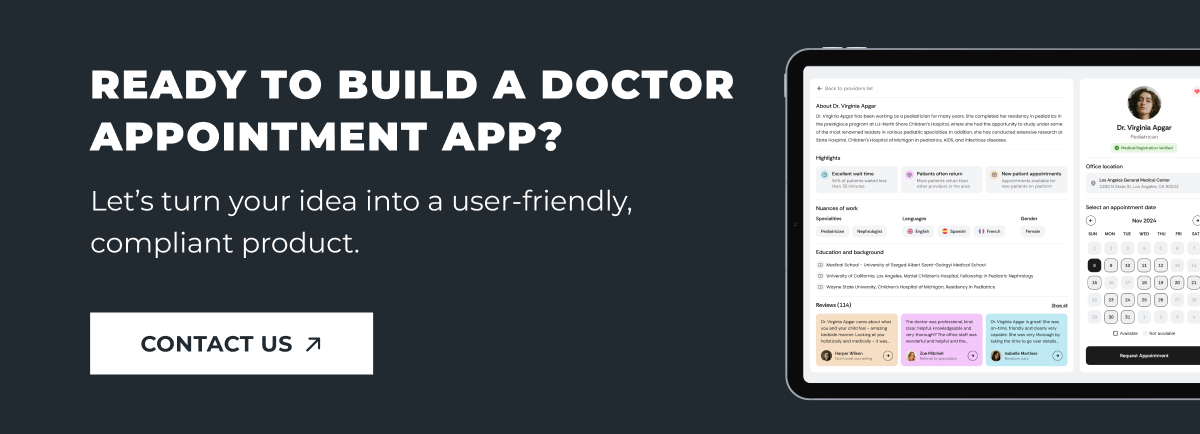
Key Features to Include in Your Doctor Appointment App
To put it generally, a well-designed doctor appointment app should build trust, make patient-doctor interaction easy, and fit naturally into everyday medical workflows.
Below is a detailed breakdown of the core and advanced features you should prioritize when you build doctor appointment app for each group: patients, doctors, and administrators.
Key doctor appointment app features for patients
The patient-facing side of the app is all about accessibility, simplicity, and reassurance. It should help users manage their healthcare with confidence, starting with the right doctor and ending with follow-up visits.
Here are the features that grant this smooth experience:
- Appointment booking and calendar view. This is the core functionality — users must be able to view doctors’ real-time availability and book specific time slots instantly. The interface should make it easy to reschedule or cancel without friction.
- Personal profile and medical history. Each user should have a personal profile with key health details: age, gender, allergies, past diagnoses, medications, and insurance information.
- Doctor search and filtering. Users should be able to browse and filter doctors based on specialization, availability, location, experience, languages spoken, or user reviews.
- Secure online payments and invoices. Users must have access to trusted payment gateways such as Stripe, PayPal, or Apple Pay to process transactions. This feature should also include automatic invoicing, refund options, and transparent pricing upfront.
- Push notifications and reminders. Notifications reduce no-shows and improve patient engagement. Common examples include appointment confirmations and reminders, doctor availability changes, prescription refill alerts, or health check prompts.
Key doctor appointment app features for healthcare providers
The doctor dashboard is designed for clarity and productivity. It helps healthcare providers manage appointments, view patient information, and communicate safely.
- Calendar management. Doctors should have a dynamic scheduling system that syncs across all devices. It should handle appointments, cancellations, and reschedules automatically while displaying the status of each slot.
- EHR/EMR access. Direct integration with EHR or EMR systems assures that doctors can review patient histories, prescriptions, allergies, and past test results without switching tools. Data should be easily retrievable and editable, with access controls to prevent unauthorized editing or downloads.
- Appointment confirmation and cancellation. A responsive workflow for handling last-minute changes is central. Doctors should be able to approve, reschedule, or cancel appointments directly from their dashboard, with instant patient notification.
- Performance dashboard. Doctors and clinic owners benefit from visual dashboards showing key data like daily/weekly appointment volume, no-show rate trends, average consultation time, patient satisfaction scores, or feedback summaries.
Key doctor appointment app features for admins
The administrative panel runs the whole system, securing compliance, protecting data integrity, and managing users and transactions across the platform.
- Clinic and user management. Admins should be able to manage all registered doctors, clinics, and patients, verify licenses, and assign user roles. The system must allow role-based permissions (for example, receptionists, supervisors, or IT support) to ensure security and accountability.
- Payment and transaction tracking. The platform should track all transactions, handle refunds, and generate detailed billing reports.
- Reports and analytics. Admins should have access to data dashboards visualizing platform performance: total bookings, revenue growth, active users, and feedback trends. These analytics support ongoing product improvements and help shape better business strategies.
Advanced features to add
As competition grows, incorporating next-generation features may help your app stand apart and provide real value to users.
- AI-powered symptom checker. An intelligent chatbot or AI module can interpret user-entered symptoms and provide general health insights or possible next steps, such as recommending consultation with a qualified specialist. It doesn’t replace professional medical advice but helps patients better understand which type of care might be relevant and navigate their healthcare journey more confidently.
- In-app chat or video consultation. While this is a core feature for telemedicine or virtual-care apps, it can also serve as a valuable advanced feature for other types of doctor appointment platforms. Built-in chat and video functionality let users communicate with doctors, share documents, and conduct remote consultations directly within the app.
- Machine learning-based scheduling optimization. Machine learning can study user patterns to predict cancellations, optimize appointment slots, and balance doctor availability. For instance, the system might suggest opening early morning slots for users who frequently cancel evening appointments.
- Multilingual support and localization. For apps targeting diverse markets, offering language flexibility is a smart move. Localized interfaces, currency settings, and culturally aware design improve user comfort and trust across regions.
When these features come together effectively, the result is an app that empowers patients, supports providers, and enables smarter, more connected healthcare delivery.
Doctor Appointment App Development Process
After reviewing the app types and features, let’s move to a practical, step-by-step scenario you can follow with your product team once you decide to begin doctor appointment booking app development. It includes six phases, each with its own deliverables and checklists. You can adjust the scope depending on whether you’re building an app for a single clinic, a marketplace, or a telemedicine-focused product.
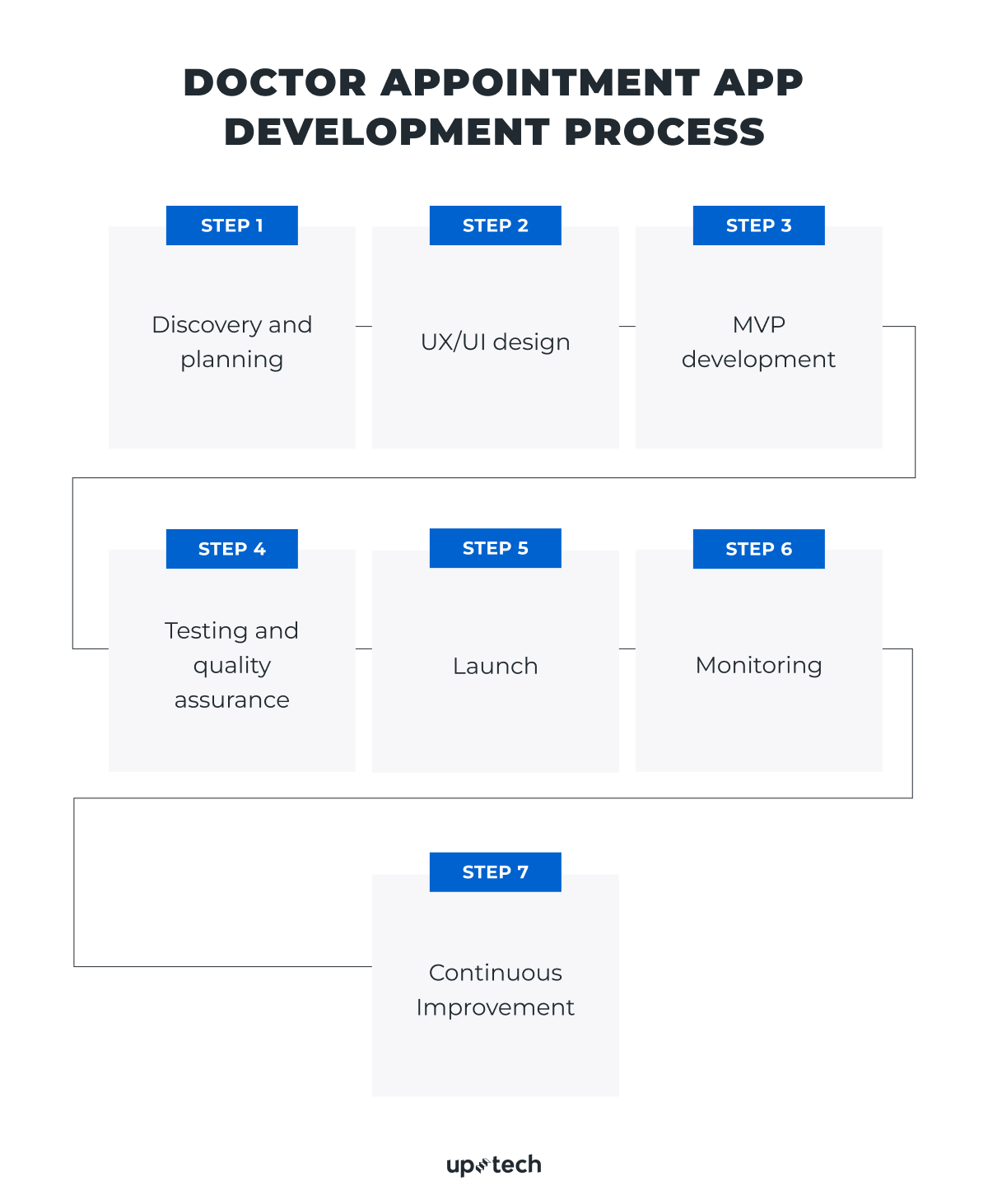
1. Discovery and planning
The goal of this stage is to align on business outcomes, users, and regulatory scope before you start to develop a doctor appointment app.
What should you do during this stage:
- Stakeholder interviews and workflow mapping. Talk to the people who live the process daily: front-desk staff, clinicians, patients, billing teams, and compliance officers. Document both the current “as-is” flow (call center → calendar → visit → billing) and the future “to-be” digital experience.
- User research. Conduct 6–12 in-depth interviews and short surveys to identify booking triggers, friction points (like insurance verification, no-shows), accessibility requirements, and trust drivers (like data security or doctor credibility).
- Market and regulatory scan. Benchmark competitors and list out must-have and differentiator features. Identify compliance frameworks, confirm data residency rules, and plan integrations with FHIR/HL7 systems if EHR connectivity is required.
- Value metrics and guardrails. Define what success looks like to you. Metrics might include percentage of online bookings, reduction in no-shows, average time-to-appointment, NPS / CSAT improvement (set clear non-negotiables like patient data privacy, audit trails, and uptime standards).
- Product strategy and MVP scope. Prioritize core MVP features (user onboarding, doctor search, booking flow, push notifications, payments). Defer advanced features to later phases based on impact and complexity.
- Technical blueprint. Together with the tech team or a partner doctor appointment app development company, draft a high-level architecture including backend stack and hosting (for example, AWS, Firebase, Azure), integration inventory (EHR/EMR, Stripe for payments, Twilio or Agora for calls/video), data model overview (users, appointments, prescriptions), buy-vs-build analysis for SDKs or third-party services.
Key deliverables:
- Problem statement + OKRs
- User personas and journey maps
- Risk register (security, legal, integration)
- Architecture diagram and integration plan
- MVP scope + phased roadmap and budget range
- Low-fidelity or clickable prototype of selected core functionality to validate user flow and technical feasibility
2. UX/UI design
The ultimate goal here is to ship trust-centric flows that are effortless for patients and efficient for staff. This stage can overlap with late discovery.
What should you focus on:
- Information architecture. Together with the design team, define the structural foundation across three primary modules — the patient app, doctor portal, and admin console. Map user roles, permissions, and data visibility levels (for example, a doctor can view appointments but not billing details; an admin can manage users and reports).
- Critical paths. Design all essential flows from start to finish: onboarding, doctor discovery, slot selection, payment, teleconsultation, and follow-up. Don’t skip failure branches: handle what happens if a doctor cancels, a payment fails, or a video call disconnects. These small moments define perceived reliability.
- Trust and safety cues. Embed reassurance throughout the interface. To build application for doctor appointment that users can trust, include verified doctor credentials, transparent pricing, visible security badges, and clear consent language. Add privacy microcopy (“Your medical data is encrypted and never shared without consent”) to build confidence subtly but effectively.
- Design systems. Your team should establish a reusable design system early. Define tokens (spacing, typography, colors), UI components (buttons, modals, alerts), and an error-messaging library to keep tone and function consistent. Document states for validation, success, and failure scenarios, especially in forms and payments.
- Prototyping and testing. Develop clickable prototypes for mobile and web. Run 2–3 usability testing loops with 5–7 target users each, focusing on task comprehension and time-to-complete. Collect feedback on intuitiveness, emotional response, and perceived trustworthiness. Then, iterate quickly between sessions.
Key deliverables:
- Complete user flows and wireframes
- High-fidelity UI screens and an updated design system
- Interactive prototype tested with real users
- Content style guide covering tone, medical disclaimers, and microcopy standards
3. MVP development
The goal here is to build the first working version of the app that real users can use to book appointments and manage their healthcare experience. The focus is on validating the idea before investing in advanced features.
As you move into the practical doctor appointment application development stage, remember that the MVP should make the user journey fully functional yet simple. It needs to deliver core value without unnecessary complexity.
Core functionality:
- Patients: create accounts, find doctors, book visits, make payments, and receive reminders.
- Doctors: manage schedules, confirm or cancel appointments, and communicate securely with patients.
- Administrators: oversee users, payments, and overall system activity through an admin panel.
Key considerations:
From the very beginning, doctor appointment mobile app development must prioritize data privacy and security, ensuring compliance with medical regulations to protect patient information.
Timeline:
MVP development typically takes 8–14 weeks, structured into short, focused sprints.
- Early sprints: user sign-up, doctor search, and scheduling.
- Mid-phase: payments and video consultations.
- Final phase: reporting tools and performance optimization.
Throughout the process, the team should maintain stability, performance, and security as top priorities.
Key deliverables:
- Fully functional MVP with core patient, doctor, and admin features
- Secure and compliant infrastructure
- Tested, stable product ready for pilot use
- Initial user feedback and improvement plan
- Backlog of next-phase enhancements

4. Testing and quality assurance
Testing and QA are not isolated steps at the end of developing a doctor appointment app. They run continuously throughout the design, implementation, and release cycles. The goal is to make sure that every feature delivered works correctly, performs efficiently, remains secure, and is accessible to all users. This ongoing process verifies that the product consistently meets user needs, technical requirements, and compliance standards before and after launch.
During this stage, you should focus on:
- Functionality. Check that the app behaves as expected in real-world use. Testers should thoroughly verify all aspects of the app’s functionality to make sure everything works as intended in real-world use. This includes core and edge cases alike — for instance, preventing double bookings, handling time zone differences, adapting to daylight saving changes, processing cancellations, issuing full or partial refunds, and testing any other scenarios that reflect real user behavior.
- Compatibility. The app must perform consistently across a wide range of devices and environments. Make sure QA teams test it on various iOS and Android versions, web browsers, and even low-end or older phones. They also need to simulate weak networks and offline scenarios to make sure critical actions remain functional when connectivity drops.
- Performance. Your goal in performance testing is to understand how the system behaves under pressure, not just in ideal conditions. Simulate peak loads and test how the app handles waves of reminders or notifications. Keep it running for extended periods to spot memory leaks or slowdowns. The idea is to make sure the system remains fast, stable, and reliable even during its busiest hours.
- Security. Because the app deals with sensitive health information, security testing is non-negotiable. Run both automated and manual scans to find weak spots in the code or risky dependencies. Check how tokens (JWT) are used and whether permissions prevent unauthorized access. Make sure file uploads are safe, all data is sent through encrypted connections (TLS), and every security control is set up correctly.
- Privacy and сompliance. The product must comply with frameworks like HIPAA, GDPR, and local data protection laws. Tests should confirm that consent records are stored properly, users can export or delete their data, and access logs capture every event involving personal information.
- Accessibility. Accessibility checks confirm that everyone, including users with disabilities, can comfortably use the app. QA should run screen-reader paths, test keyboard-only navigation, check color contrast ratios, and ensure support for dynamic text resizing.
- Interoperability. If the app integrates with EHR or other medical systems, interoperability testing verifies that it exchanges data correctly. Testers need to validate FHIR/HL7 message formats, simulate connection timeouts or partial failures, and check that retry mechanisms and reconciliation jobs work properly.
Key deliverables:
- Test plan, test cases, and coverage report
- Performance baselines + optimization backlog
- Penetration test report and remediations
- Accessibility conformance statement
- Compliance checklist sign-off (HIPAA/GDPR)
- Automated test suite and CI/CD integration report (may be optional)
5. Launch
The main objective during this stage is to release the app safely, track how it performs in the real world, and react quickly to any issues or user feedback. This phase bridges the gap between development and everyday operation, turning a finished product into a living service.
Before launch, ensure all operational, legal, and technical aspects are ready and aligned.
What to cover:
- App store readiness: Upload screenshots, fill in privacy labels, and include review notes required for Apple and Google approval.
- Legal setup: Finalize Terms of Use and Privacy Policy. If handling medical data, sign Business Associate or Data Processing Agreements (BAAs/DPAs).
- Data migration: Import key data (doctor profiles, specialties, pricing, clinic hours) if replacing a manual or legacy system.
- Staff enablement: Train front-desk and support teams. Provide scripts, define cancellation policies, and prepare macros or escalation paths for common issues.
These steps ensure that both the technology and the people behind it are fully prepared for launch day.
Rollout strategy:
Avoid a full-scale release right away. Start with a limited pilot — for example, in one city, a specific clinic network, or a small user group. This controlled rollout helps test performance, gather feedback, and make adjustments before scaling.
Scaling and optimization:
- Gradually enable advanced features (telemedicine, online payments, AI-based tools) using feature flags.
- Set up analytics to track conversion rates, monitor the booking funnel, and measure user satisfaction.
- Implement synthetic monitoring and an on-call rotation to detect and resolve issues in real time.
Key deliverables:
- Successful soft launch or regional pilot with performance benchmarks
- Verified app store listings (Apple App Store and Google Play)
- Legal documentation package (Terms of Use, Privacy Policy, BAAs/DPAs)
- Data migration logs and validation report
- Staff training materials and support documentation
- Live monitoring dashboard and incident escalation plan
- Post-launch checklist with issue-tracking setup
6. Monitoring
Monitoring aims to provide continuous visibility into how the product performs across technical, operational, and business dimensions, so the team can quickly detect issues, measure progress, and maintain a high-quality, reliable user experience.
After you build an application for a doctor appointment, your product and engineering teams track several dimensions of performance and business health. Specifically:
- User and engagement metrics: conversion to booked visits, average time-to-appointment, no-show and cancellation rates, repeat bookings, and overall satisfaction (CSAT/NPS).
- Technical health: API latency, error logging, crash-free sessions, push notification delivery rates, and video call success rate.
- Security signals: failed login attempts, abnormal data exports, and admin actions logs.
- Business performance: revenue per doctor per day, marketplace fill rate, and provider activation numbers.
These metrics give a full picture of how the app performs — both technically and commercially.
Key deliverables:
- Centralized monitoring dashboard (covering product, technical, and business KPIs)
- Real-time alerting and incident-response system integrated with communication tools (for example, Slack, PagerDuty)
- Regular performance and uptime reports
- Security event logs and access audit trail repository
- Automated error tracking and crash reporting setup
7. Continuous improvement
The goal is to continually improve the product based on real user data, scaling responsibly while maintaining optimal performance, security, and trust.
Once the app is live, decisions should be guided by actual usage data rather than assumptions.
- Analyze booking funnels to identify where users drop off (e.g., during insurance verification or payment).
- Design improvements that simplify the user experience.
- Experiment with no-show reduction tactics such as adjusting reminder timing or adding small deposits.
- Gather feedback through post-visit surveys and review data to track satisfaction and care outcomes.
Performance and security:
As user activity increases, the app must remain resilient and compliant.
- Conduct regular capacity planning and performance tuning to ensure scalability.
- Run regular penetration tests, chaos drills, and vendor audits to maintain reliability and compliance.
- Review access rights, data retention policies, and update all SDKs, dependencies, and OS versions.
- Follow each update with full regression testing to prevent new issues.
Governance and strategy:
Strong governance keeps growth sustainable and aligned with healthcare standards.
- Hold quarterly roadmap reviews with clinical and compliance leaders to ensure new features meet both regulations and user needs.
- Conduct post-launch impact reviews to measure progress against OKRs.
- Involve patient advisory panels for ongoing, honest feedback that guides ethical, user-centered development.
Key deliverables:
- Quarterly roadmap with prioritized improvements
- Data-driven optimization reports and experiment results
- Updated security and reliability documentation
- Compliance and audit summaries
- Post-release performance and OKR reviews
Challenges in Building a Doctor Appointment App
Below are the most common challenges a product team from even an experienced doctor booking app development company could face, and the strategies to overcome them.

Real-time scheduling conflicts and scalability
As you build an app to make doctor appointments, keep in mind that healthcare scheduling changes constantly — doctors cancel, extend working hours, or update clinic calendars throughout the day. If multiple users are booking simultaneously or if the clinic uses external systems (like EHR software or shared calendars), data synchronization becomes difficult. Double-bookings, inconsistent time slots, or unsynced cancellations can quickly erode trust and efficiency.
Why it’s tricky:
- Each clinic may use different calendar structures or time-zone formats.
- Bookings can be modified externally (like front-desk software), so your app needs two-way sync.
- Some APIs send updates with delays, which leads to short-lived inconsistencies.
- During peak load (like flu season or vaccination campaigns), the system must handle thousands of concurrent users.
Solutions:
- Implement a centralized booking engine that serves as the single source of truth across all systems.
- Use atomic transactions and locking mechanisms to prevent double-booking (for example, when two patients try to book the same slot).
- Adopt idempotent requests so repeated network calls don’t duplicate reservations.
- Sync external calendars via webhooks or event queues (Kafka, RabbitMQ) instead of periodic polling.
- Use horizontal scaling (Kubernetes, load balancers) and caching (Redis) to maintain real-time performance under heavy load.
- Build a retry and reconciliation service that corrects mismatched data between systems automatically.
Building trust through design and transparency
Healthcare is deeply personal. Patients share medical records, payment data, and even mental health information through your platform. If the app looks cluttered, insecure, or impersonal, users will hesitate to engage. Trust is both a design and communication challenge.
Why it’s tricky:
- Users may not understand data-protection mechanisms, so their perception of safety relies on visual and interaction cues.
- The design must balance friendliness and professionalism.
- Consent and privacy steps can add friction, hurting conversion if not handled smoothly.
Solutions:
- Prioritize UX clarity and transparency: use plain-language consent forms and clear privacy explanations.
- Display doctor credentials, clinic verification badges, and reviews prominently.
- Provide visible security cues (for example, “All data encrypted,” lock icons, verified payments).
- Use calm color palettes, high readability fonts, and consistent UI patterns — users associate visual order with reliability.
- Include human touchpoints: doctor photos, personalized reminders, and empathetic copywriting.
- Create onboarding flows that educate users on how their data is handled and stored.
- Conduct regular UX trust audits to observe whether new users hesitate at any privacy-related screens.
Building trust is the foundation of user retention in healthcare. If patients don’t feel safe, no technical feature will save the product.
Integration with legacy healthcare systems
Many clinics and hospitals still rely on outdated electronic medical records (EMR) or practice-management systems built decades ago. These legacy tools might not have modern APIs, follow different data standards, or store information in unstructured formats (Excel, PDFs). Integrating with them is one of the hardest technical barriers in doctor appointment software development.
Why it’s tricky:
- Legacy EMRs often lack RESTful or FHIR interfaces, requiring custom adapters or middleware.
- Some systems store data on-premises and can’t easily expose external endpoints due to security concerns.
- Data schemas vary — what one system calls “patient_id” another calls “record_number.”
- Poor documentation and vendor lock-ins make development cycles unpredictable.
Solutions:
- Use FHIR and HL7 as your base data models, even if you must convert legacy data into those formats internally.
Implement an integration gateway or middleware layer that handles translation, synchronization, and queuing between systems. - Adopt ETL (Extract, Transform, Load) pipelines for periodic syncs if real-time integration isn’t feasible.
- Prioritize data integrity: maintain versioning and audit logs to detect inconsistencies or overwrites.
- Where APIs aren’t available, use secure file-based or database replication approaches under strict encryption.
- Plan for a phased integration strategy: start with read-only access, then add write operations once stability is proven.
- Work closely with client IT and compliance teams to negotiate access protocols, downtime windows, and fallback modes.
Regulatory and security complexity
Doctor scheduling app development involves handling sensitive health data and comes with strict legal responsibilities. Each jurisdiction has its own privacy and security requirements, and breaches can cost millions in fines and reputation loss. Developers often underestimate the scope of compliance until late in the project.
Why it’s tricky:
- Compliance frameworks (HIPAA, GDPR, PIPEDA, etc.) differ in terminology and enforcement.
- In doctor booking app development, you must ensure end-to-end encryption, secure data storage, and auditability, not just login protection.
- Even harmless features (push notifications, analytics) can accidentally expose health data.
Solutions:
- Embed compliance from day one: design with “privacy by design” principles.
- Use role-based access control and least-privilege principles for all staff.
- Use encryption to protect patients’ health data (PHI) both while it’s being sent and while it’s stored.
- Separate PII (Personally Identifiable Information) — such as name, email, or date of birth — from PHI (Protected Health Information). This significantly reduces the risk of exposing both datasets in a single breach.
- Maintain immutable audit logs for every access, modification, or export of medical data.
- Separate analytics data from identifiable patient data.
- Conduct third-party security audits annually and maintain incident response playbooks.
- Obtain necessary BAAs (Business Associate Agreements) with vendors and cloud providers (AWS, Google Cloud).
Maintaining performance and reliability at scale
Ensuring stable performance is one of the toughest challenges in online doctor appointment app development. A doctor appointment platform must handle thousands of concurrent users: patients booking, doctors updating schedules, and admins processing data, without downtime or lag. In healthcare, even a few seconds of delay can lead to frustration, missed visits, or system distrust.
Why it’s tricky:
- Traffic spikes can be unpredictable — during flu season or emergencies, user load can double overnight.
- Real-time features like video consultations, chat, and live schedule updates require low-latency infrastructure.
- Third-party integrations (payments, notifications, EHR systems) can create bottlenecks or cascading failures.
- Healthcare data loads (EHR sync, test results, analytics) grow exponentially as your user base expands.
Solutions:
- Design a scalable, modular architecture using microservices and load balancers to distribute requests efficiently.
- Implement asynchronous job queues for heavy or background tasks (notifications, reports, analytics).
- Continuously monitor uptime and latency using tools like Prometheus, Grafana, or Datadog to detect issues early.
- Introduce circuit breakers and fallback mechanisms for third-party APIs to prevent system-wide failures.
- Plan for redundancy and disaster recovery with multi-region deployments, automated backups, and regular failover drills.
- Regularly stress-test the system under peak loads to ensure consistent performance and reliability as you scale.
Localization and accessibility challenges
Expanding a doctor appointment app beyond one region means addressing not only language but also cultural expectations, accessibility, and usability across devices and demographics. In healthcare, misunderstanding an interface or missing an accessibility feature can prevent someone from getting timely care.
Why it’s tricky:
- Localization involves adapting currencies, time zones, measurement units, and medical terminology.
- Cultural differences affect how users expect to book appointments, share data, or receive notifications.
- Accessibility standards vary by region, and failing to meet them can exclude users with visual, auditory, or motor impairments.
- Testing across languages and assistive technologies adds complexity and time to online doctor scheduling app development.
Solutions:
- Build a multi-language architecture from the start using i18n libraries and localization frameworks.
- Adapt UX and content for each market: date/time formats, privacy notices, consent wording, and appointment categories.
- Follow WCAG 2.1 accessibility guidelines. Include features like screen reader support, high-contrast themes, large tap targets, and voice commands.
- Separate localized content from the codebase to simplify updates and translations.
- Conduct usability testing with real users in each target region to ensure linguistic accuracy and cultural relevance.
- Make localization and accessibility part of your ongoing QA cycle, not a post-launch fix.
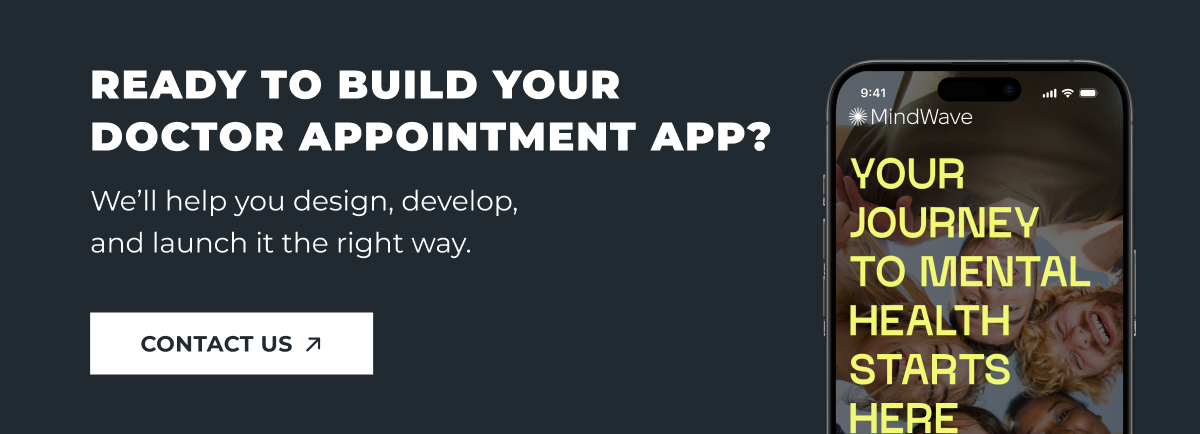
Uptech’s Experience in Healthcare App Development
At Uptech, we’ve spent years helping healthcare innovators bring their ideas to life, turning complex medical processes into digital products that feel effortless for users and secure for providers. Our experience as a doctor appointment app development company has refined how we build secure, scalable, and compliant digital ecosystems for healthcare clients worldwide.
Over time, we’ve worked across diagnostics, mental health, and medical data automation — and each case taught us something new about how to develop a doctor appointment booking app that truly supports care.
MicroGenDX
MicroGenDX, a U.S.-based healthcare company specializing in microbial DNA diagnostics (qPCR and NGS), partnered with Uptech to build a new B2C web platform, custom admin panel, and native iOS/Android apps. The goal was to improve the patient journey from test ordering to result access while ensuring full HIPAA and GDPR compliance.

Solution:
Uptech implemented secure data encryption, used Azure Key Vault for confidential data, and integrated Osano for privacy preference management. The system includes real-time order tracking, barcode scanning, and role-based access for staff.
To support scalability, the platform was built with Next.js, TypeScript, NestJS, PostgreSQL, and hosted on Azure. It integrates with Shopify (as a headless CMS) and Shippo for delivery aggregation and tracking.
Impact:
The solution streamlined order management, enhanced user privacy and security, and allowed MicroGenDX to expand its direct-to-consumer testing service across the U.S. and Europe.
Read a full case study here.
Medical Documents Processing System
Another one of our clients, a private clinic in the U.S., sought to optimize workflow automation as it scaled its operations. The partnership involved a team of six to build a web-based solution.
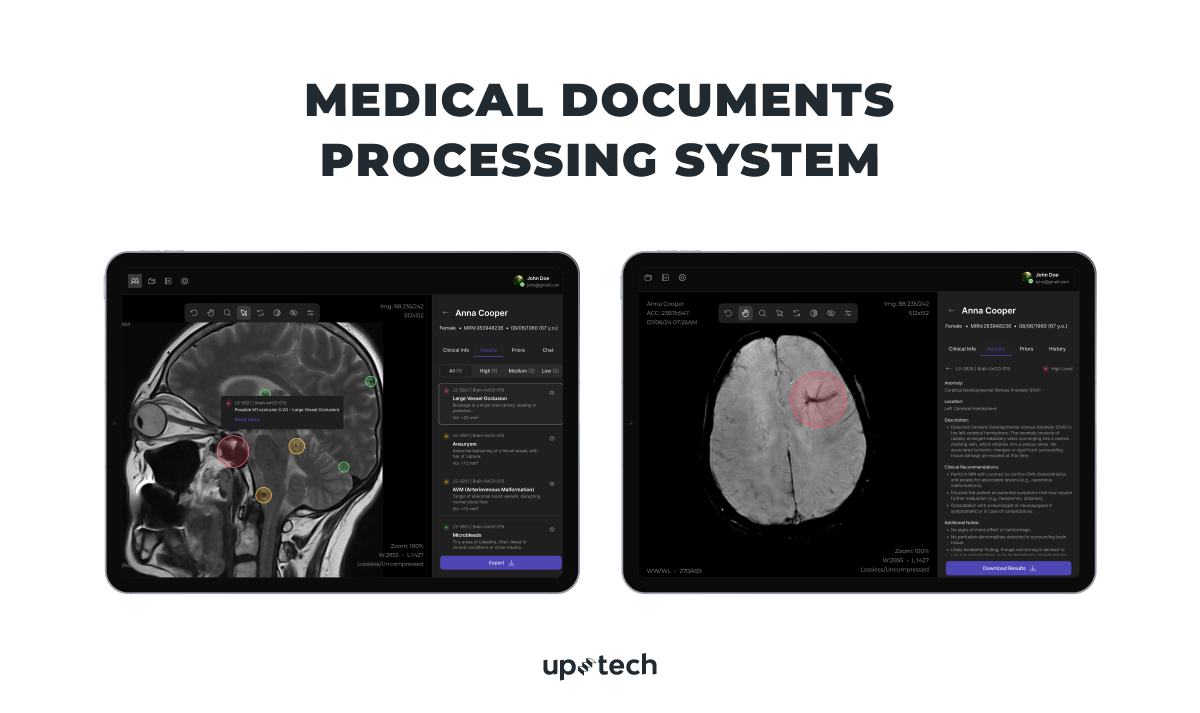
Our solution:
We developed an AI-driven document-processing system featuring OCR to digitize one-page typed documents and NLP to classify medical documents by type (such as lab reports, prescriptions, or patient notes). The system also included an anomaly-detection module to flag inconsistencies (such as conflicting test results or missing data) in patient records.
Results:
Following the implementation, document analysis time was reduced by up to 30%. The client achieved better workflow efficiency, allowing healthcare professionals to focus more on patient care.
Check all the details in our case study.
Conclusion
The future of healthcare is digital and personal. Patients expect fast, transparent, and secure access to care, while providers seek tools that simplify their workflows without sacrificing compliance.
Uptech’s doctor appointment app development services help healthcare organizations make that future real. From concept validation to product launch, we build secure, scalable, and human-centered platforms that connect patients and doctors through technology they can trust.
Have a healthcare app idea and looking for a doctor appointment app development company? Let’s bring it to life together.
Contact Uptech for a free consultation to discuss your next healthcare innovation.











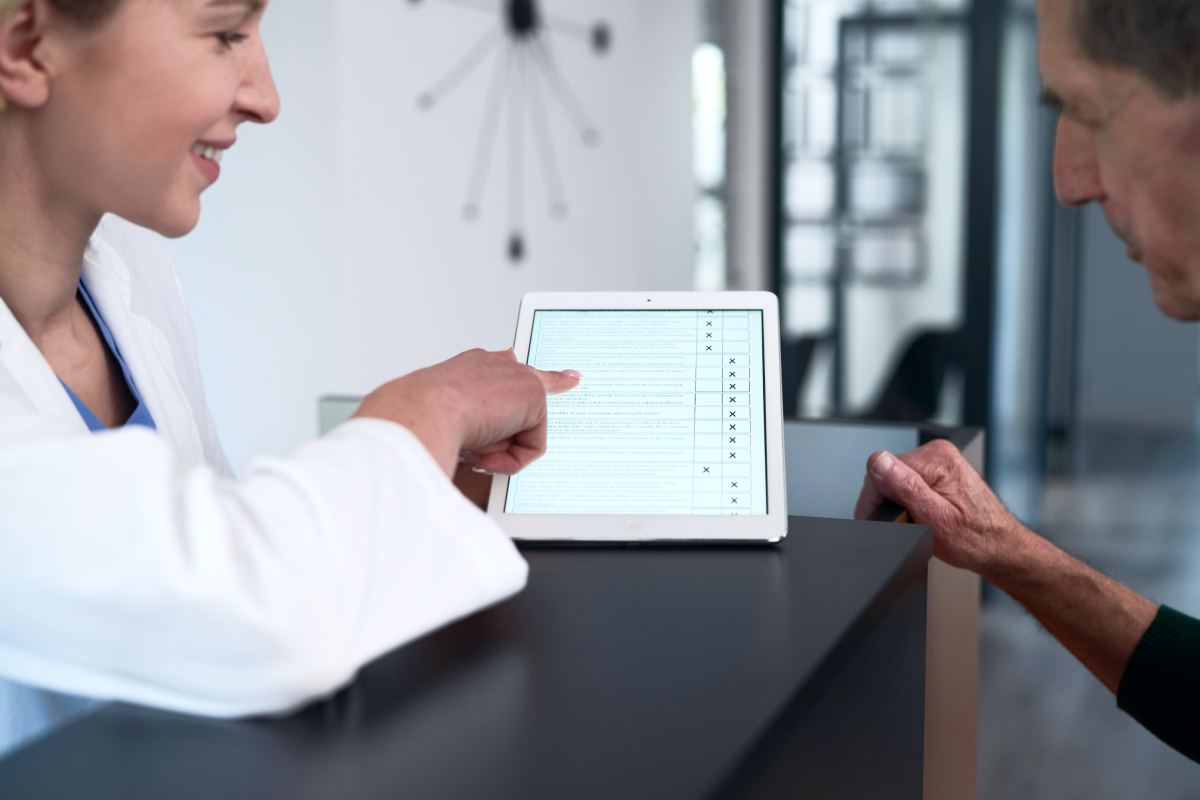












































































.avif)












